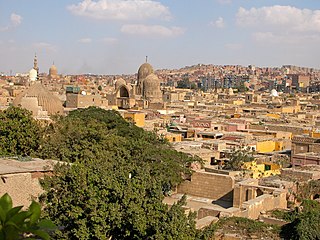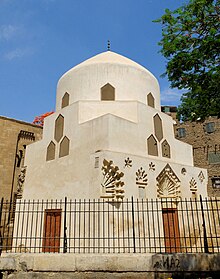
The Ayyubid dynasty, also known as the Ayyubid Sultanate, was the founding dynasty of the medieval Sultanate of Egypt established by Saladin in 1171, following his abolition of the Fatimid Caliphate of Egypt. A Sunni Muslim of Kurdish origin, Saladin had originally served the Zengid ruler Nur ad-Din, leading Nur ad-Din's army in battle against the Crusaders in Fatimid Egypt, where he was made Vizier. Following Nur ad-Din's death, Saladin was proclaimed as the first Sultan of Egypt by the Abbasid Caliphate, and rapidly expanded the new sultanate beyond the frontiers of Egypt to encompass most of the Levant, in addition to Hijaz, Yemen, northern Nubia, Tarabulus, Cyrenaica, southern Anatolia, and northern Iraq, the homeland of his Kurdish family. By virtue of his sultanate including Hijaz, the location of the Islamic holy cities of Mecca and Medina, he was the first ruler to be hailed as the Custodian of the Two Holy Mosques, a title that would be held by all subsequent sultans of Egypt until the Ottoman conquest of 1517. Saladin's military campaigns in the first decade of his rule, aimed at uniting the various Arab and Muslim states in the region against the Crusaders, set the general borders and sphere of influence of the sultanate of Egypt for the almost three and a half centuries of its existence. Most of the Crusader states, including the Kingdom of Jerusalem, fell to Saladin after his victory at the Battle of Hattin in 1187. However, the Crusaders reconquered the coast of Palestine in the 1190s.

The Bahri Mamluks, sometimes referred to as the Bahri dynasty, were the rulers of the Mamluk Sultanate of Egypt from 1250 to 1382, following the Ayyubid dynasty. The members of the Mamluk ruling class were purchased as slaves (mamluks) and manumitted, with the most powerful among them taking the role of sultan in Cairo. While several Bahri Mamluk sultans tried to establish hereditary dynasties through their sons, these attempts were ultimately unsuccessful, with the role of sultan often passing on to another powerful Mamluk.
Al-Malik as-Salih Najm al-Din Ayyub, nickname: Abu al-Futuh, also known as al-Malik al-Salih, was the Ayyubid ruler of Egypt from 1240 to 1249.

Izz al-Din Aybak was the first of the Mamluk sultans of Egypt in the Turkic Bahri line. He ruled from 1250 until his death in 1257.

Shajar al-Durr, also Shajarat al-Durr, whose royal name was al-Malika ʿAṣmat ad-Dīn ʾUmm-Khalīl Shajar ad-Durr, was a ruler of Egypt. She was the wife of As-Salih Ayyub, and later of Izz al-Din Aybak, the first sultan of the Mamluk Bahri dynasty. Prior to becoming Ayyub's wife, she was a child slave and Ayyub's concubine.
Pope Athanasius III of Alexandria, 76th Pope of Alexandria and Patriarch of the See of St. Mark.

There have been many architectural styles used in Egyptian buildings over the centuries, including Ancient Egyptian architecture, Greco-Roman architecture, Islamic architecture, and modern architecture.
Faris al-Din Aktay al-Jamdar was a Turkic-Kipchak Emir (prince) and the leader of the Mamluks of the Bahri dynasty.

An-Nasir Yusuf, fully al-Malik al-Nasir Salah al-Din Yusuf ibn al-Aziz ibn al-Zahir ibn Salah al-Din Yusuf ibn Ayyub ibn Shazy, was the Ayyubid Kurdish Emir of Syria from his seat in Aleppo (1236–1260), and the Sultan of the Ayyubid Empire from 1250 until the sack of Aleppo by the Mongols in 1260.

The City of the Dead, or Cairo Necropolis, also referred to as theQarafa, is a series of vast Islamic-era necropolises and cemeteries in Cairo, Egypt. They extend to the north and to the south of the Cairo Citadel, below the Mokattam Hills and outside the historic city walls, covering an area roughly 4 miles (6.4 km) long. They are included in the UNESCO World Heritage Site of "Historic Cairo".

The Qalawun complex is a massive pious complex in Cairo, Egypt, built by Sultan al-Mansur Qalawun from 1284 to 1285. It is located at Bayn al-Qasrayn on al-Mu'izz street and like many other pious complexes includes a hospital (bimaristan), a madrasa and mausoleum. Despite controversy surrounding its construction, this building is widely regarded as one of the major monuments of Islamic Cairo and of Mamluk architecture, notable for the size and scope of its contributions to legal scholarship and charitable operations as well as for the richness of its architecture.

Bayn al-Qasrayn is an area located along al-Mu'izz Street in the center of medieval Islamic Cairo, within present day Cairo, Egypt. It corresponds to what was formerly a plaza between two palace complexes constructed in the 10th century by the Fatimids, as part of their palace-city named al-Qahirah. This later became the site of many monumental buildings constructed during the Ayyubid, Mamluk, and Ottoman periods, up to the 19th century. Many of these historical monuments are still standing today.

Dayfa Khatun was a Kurdish Ayyubid princess, and the regent of Aleppo from 26 November 1236 to 1242, during the minority of her grandson An-Nasir Yusuf. She was an Ayyubid princess, as the daughter of Al-Adil, Sultan of Egypt. She married her first cousin, Az-Zahir Ghazi, Emir of Aleppo, which marked the end of the rivalry between the two branches of the family.

The Salihiyya Madrasa, also called the Madrasa and Mausoleum of as-Salih Najm ad-Din Ayyub is a historic madrasa and mausoleum complex in Cairo, Egypt. The complex was founded by the Ayyub sultan As-Salih Ayyub in 1242 and his mausoleum was added to it by Shajarr ad-Durr upon his death in 1249. It was one of the most prominent centers of Islamic learning in the Ayyubid and Mamluk era in the 13th–14th centuries CE. Its remains are located on al-Muizz Street in the historic district of Cairo across from the Complex of Sultan Qalawun.

Mamluk architecture was the architectural style that developed under the Mamluk Sultanate (1250–1517), which ruled over Egypt, the Levant, and the Hijaz from their capital, Cairo. Despite their often tumultuous internal politics, the Mamluk sultans were prolific patrons of architecture and contributed enormously to the fabric of historic Cairo. The Mamluk period, particularly in the 14th century, oversaw the peak of Cairo's power and prosperity. Their architecture also appears in cities such as Damascus, Jerusalem, Aleppo, Tripoli, and Medina.
Al-Ashraf Muzaffar ad-Din Musa was the last, albeit titular, Ayyubid Sultan of Egypt as the puppet of Izz ad-Din Aybak.

The Mausoleum of Imam al-Shafi’i(Arabic: قبة الإمام الشافعي ) is a mausoleum dedicated to Imam Al-Shafi’i, one of the four Sunni Imams who founded the Shafi’i Sunni Islamic school of jurisprudence. Located at the Imam Shafi’i Street in the City of the Dead, Cairo, the mausoleum is a hallmark of Ayyubid style architecture and historical significance.

The Mashhad of Sayyida Ruqayya, sometimes referred to as the Mausoleum or Tomb of Sayyida Ruqayya, is a 12th-century Islamic religious shrine and mosque in Cairo, Egypt. It was erected in 1133 CE as a memorial to Ruqayya bint Ali, a member of the Islamic prophet Muhammad's family. It is also notable as one of the few and most important Fatimid-era mausoleums preserved in Cairo today.
Shajarat al-Durr is an Egyptian film released in 1935. It is considered the first historical feature film produced in Egypt.




















